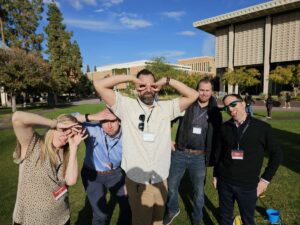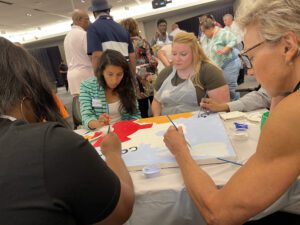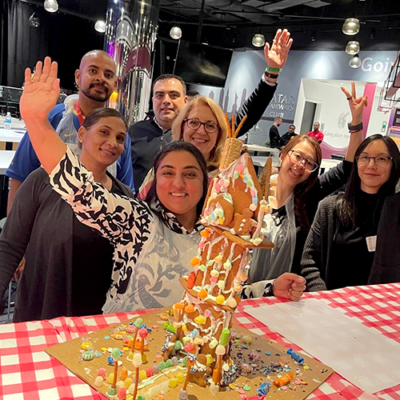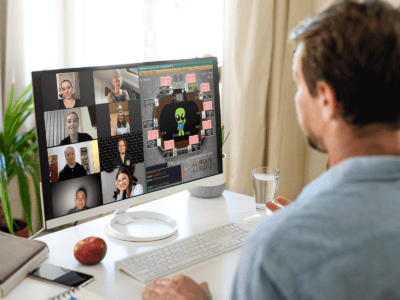You’ve probably noticed an increased focus on gamification in the workplace in recent years. It’s not without reason—workplace gamification can be an incredibly effective way to increase employee engagement!
Gamification refers to the application of game elements to non-game scenarios, such as work or studying, to motivate people and boost their engagement.
Today, we’ll take a deeper look at game-based learning and how workplace gamification can increase employee engagement. We’ll also explore the basics of gamification, its benefits, and ideas to incorporate it with your team.
Understanding Gamification in the Workplace
Workplace gamification integrates game concepts in order to introduce an element of fun to motivate and engage people for things like work, productivity, and learning. Common elements used in gamification at work include:
- Point scoring
- Friendly competition
- Leaderboards
- Prizes & rewards
- Game-like rules
This isn’t just a fun trend—research backs up the benefits of using gamification for employee engagement.
According to a Mambo report, effective gamification in the workplace can increase employee engagement by 48%. That same report also found that 95% of employees prefer a gamified work environment.
These results aren’t surprising if you consider what actually happens when you gamify workplace tasks. For example, adding elements like a prize for the person who makes the most sales is also known as incentivizing performance, which is a time-tested tactic.
Employee gamification is a modern way of creating an environment to encourage productivity and inspire workplace engagement. This is something Stephen Baer, Co-Founder and CCO of The Game Agency, noted in one of our podcasts, saying:
“Companies need to think about providing an ecosystem where they can drive that motivation. Whether it’s intrinsic or extrinsic motivation, really pushing that employee to participate in the greater cause.”
What Happens When You Use Gamification in the Workplace
By using gamification techniques, businesses can create a workplace where employees are more motivated to complete projects and do their best. They might even feel like they’re having fun completing their daily tasks.
This creates better outcomes for the business as a whole.
A Zippia report found that 90% of employees say their productivity increases when the workplace is gamified; it also found that gamified workplaces are seven times more profitable than non-gamified workplaces.
So, if you need to engage your employees, gamification in the workplace is one of the best options available.
Examples of Workplace Gamification
If your marketing team is working on a big campaign, offering a reward of an extra vacation day to whoever comes up with the winning proposal can make a huge difference.
That extra vacation day can be a huge motivator for employees since they’ll likely work harder than usual to ensure they have a shot at winning. And in doing so, employees also become more engaged.
Likewise, if you create a points system for your sales team and offer prizes for first, second, and third place, you’re incentivizing higher sales in a fun, modern way and inspiring everyone to work harder.
Benefits of Gamification in the Workplace
It’s important to fully understand the benefits of gamification in the workplace if you want to implement it as effectively as possible. Here are some of the most impactful benefits:
Improves Employee Engagement
The biggest benefit of gamification at work is that it increases employee engagement. Engagement is all about the connection between employees, their job, and their workplace.
Gamification helps employees connect on a deeper level with their work by driving participation. By using game elements and inventive games to motivate employees, they’ll naturally want to win and do better, which ultimately leads to higher engagement.
Of course, engagement has numerous benefits of its own. Engaged employees are generally more satisfied and productive, which increases business outcomes.
Makes Engagement and Learning Fun
Game-based learning also helps keep employee engagement fun. Sure, many people assume employee engagement exercises will be boring or dry, but gamification changes that.
Your team will be looking forward to engagement exercises before you know it! The same is true for learning and professional development.
Gamified professional development workshops and other learning activities can help employees improve their skills while they’re having fun. When their brains are engaged in play, you’re simultaneously boosting engagement and satisfaction.
Encourages Better Collaboration
Another significant benefit of gamification in the workplace is its impact on collaboration and team dynamics. Gamified activities can strengthen and improve collaboration skills, which means better outcomes for both employees and employers alike.
Employees want to do their best to win, and that promotes collaboration if they’re working in teams. This, in turn, can boost team dynamics, which results in even stronger and more cohesive teams. It’s a cycle you won’t want to break.
Boosts Workplace Morale
It should come as no surprise that gamification can also boost morale. After all, when your employees are more engaged, having more fun, and collaborating more frequently, they’re naturally going to feel more satisfied and happy to come to work.
Like engagement, improving employee morale comes with its own host of benefits, including:
- Better employee retention
- Lower turnover rates
- Higher productivity
How to Implement Gamification in the Workplace
If your workplace isn’t gamified at all, the idea of implementing it can seem a bit overwhelming, but it’s easier than you might think. If you’ve used incentivization programs before, gamifying your workplace might even feel familiar.
Here are some actionable strategies to help businesses integrate gamification in the workplace.
Set Clear Objectives
One of the most important foundational elements of gamification at work is setting clear objectives. This allows your employees to see the finish line, which motivates them to achieve these goals as quickly and effectively as possible.
Try using SMART goals—this format is designed to create specific, measurable, achievable, relevant, and time-bound goals, which will help your team instead of hindering them. Many games use SMART goals for this very reason.
Implement Engaging Games
Instead of just using gamification as an alternate incentivization program, add some games and embrace fun more enthusiastically in your company culture. Your choice of games is incredibly important, though, so pick with care!
Look for games that are truly engaging, whether you design them yourself or partner with a company like TeamBonding. They should be relevant to your employees and their goals.
We recommend taking some time to touch base with your team so you can pick games based on their preferences and your business objectives.
Offer Real-Time Rewards and Feedback
One of the reasons that gamification in the workplace is so good for engagement is that it provides real-time rewards and feedback, which keeps employees motivated to achieve their goals. It also helps them see their progress and find ways to improve.
This can be as simple as offering team rewards for achieving each milestone on a project. Alternatively, you might create a leaderboard that tracks each employee’s progress toward individual goals, complete with rewards at checkpoints for each goal.
You might add a whiteboard to the primary office space for one or both of the ideas highlighted above so the progress toward rewards is visible on a daily basis, providing real-time feedback.
Create Healthy Competition
Fostering friendly competition and a healthy competitive mindset is a great way to boost employee engagement and productivity. Competition drives people to do better, working their hardest to come out on top.
An event like Amazing Race Around the World can be a great way to spur healthy competition. If you design your own events, do a bit of research and take precautions to ensure that competition stays friendly and doesn’t veer towards toxicity.
Alternatively, if you implement a leaderboard or something similar, you might allow employees to “level up” with each completed milestone or project. You can then create a new leaderboard to track employee levels and inspire them to hit the top rank here, too.
Gamification Ideas for Employee Engagement
We already covered some basic ideas for gamification in the workplace, but let’s dig deeper. After all, your efforts are only as effective as the games and concepts you implement.
Stephen Baer highlighted this in our podcast when he said:
“The whole point is to make the content really compelling, make sure that they can dive into it, engage with it, participate with it, and see what we learn from it. Right? And also make it a safe place to fail.”
Here are some different types of workplace gamification to inspire you to transform your office into a more fun and engaging space for everyone:
Professional Development Gamification
As we mentioned earlier, gamification can be used to make professional development fun and engaging. This means introducing game-based rewards for both professional development and learning.
For example, you could offer to pay for employees to attend seminars and training programs, then create a level-up system based on how many times each employee takes advantage of this.
Another great option is scheduling team building events like StrengthsFinder Training that focus on gamifying professional development. StrengthsFinder helps employees identify their strengths and the strengths of their colleagues in a fun, gamified way.
This is just one of many employee training programs that include gamification for professional development, employee engagement, training, and more.
Performance and Goal-Tracking Initiatives
Performance management and goal-tracking initiatives are another type of gamification that’s incredibly effective for increasing engagement, productivity, and morale.
We’ve already touched on leaderboards and challenges, both popular options. They allow employees to track their progress while encouraging them to get competitive and strive to do their best.
These tactics are even better when you tie them to equivalent rewards for each of their milestones and goals. For example, if your team completes a large project, you could reward them with a Mystery Bus event that’ll let them blow off steam outside the office.
Group Challenges and Team Building Gamification
If you’d like to focus more on the team element of gamification, group challenges and activities are great choices. This type of gamification will help bring your crew together while they’re having fun, creating a more cohesive and effective team.
Team building events are a fantastic option for this. An event like The Big Picture encourages collaboration, creativity, and a big-picture perspective while also building bonds and introducing friendly competition.
There are literally hundreds of fun team building events and activities to pick from, so look around and find one or more that are a good fit for your team and organizational objectives.
Sales Incentive Games
The last type of gamification in the workplace is sales incentive games to motivate employees, which we touched on briefly above. These tend to be some of the most straightforward options, offering rewards or prizes for achieving certain sales objectives.
For example, you might set a series of sales goals for your team, and your employees can receive a reward for each one that they achieve. Then, the person with the most sales at the end of the period might receive another special reward.
This is similar to classic incentivization, but rewards are sure to motivate employees, boost their engagement, and bring out the best in them. Bonus points if you add an 8-bit motif and employee avatars to make your leaderboard more thematic with gamification.
Ready To Boost Engagement with Gamification and Team Building?
In the past, many of us might have written gamification off as a frivolous thing, but recent research has proven that it’s highly effective at making work more engaging, motivating, and, well, fun!
Workplace gamification offers massive benefits for employees and businesses alike, boosting productivity, retention, and, ultimately, your bottom line while helping your team achieve their goals.
Team building is a fantastic way to embrace gamification as part of your corporate culture and show your employees that you’re serious about making work more fun! It’s also a powerful tool to improve collaboration and tons of other workplace skills.
At TeamBonding, we’ve spent decades studying the benefits of play and gamification, and we’re always happy to help businesses tap into these benefits. So, check out our catalog of over 200 events and start increasing employee engagement today.
Whether you use these events to kick off your gamification or as rewards to motivate your team, you’ll be driving your business further toward success.
Get in touch with us to learn more about how we can help improve your workplace through gamified team building.
















